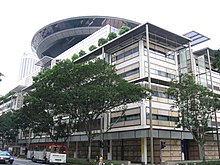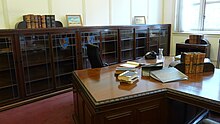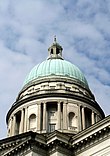Supreme Court of Singapore
1°17′26″N 103°51′2″E / 1.29056°N 103.85056°E
| Supreme Court | |||||||
|---|---|---|---|---|---|---|---|
 The Supreme Court building | |||||||
| Chinese name | |||||||
| Chinese | 最高法院 | ||||||
| |||||||
| Malay name | |||||||
| Malay | Mahkamah Terbesar Singapura | ||||||
| Tamil name | |||||||
| Tamil | சிங்கப்பூர் உச்ச நீதிமன்று | ||||||
The Supreme Court of Singapore is one of the two tiers of the court system in Singapore, the other tier being the Subordinate Courts.
The Supreme Court consists of the Court of Appeal and the High Court and hears both civil and criminal matters. The Court of Appeal hears both civil and criminal appeals from the High Court. The Court of Appeal may also decide a point of law reserved for its decision by the High Court, as well as any point of law of public interest arising in the course of an appeal from a subordinate court to the High Court, which has been reserved by the High Court for the decision of the Court of Appeal.
The High Court's jurisdiction is as follows: generally, a civil case is commenced in the High Court if the subject matter of the claim exceeds S$250,000. Probate matters are dealt with in the High Court if the value of the estate exceeds S$3 million or if the case involves the resealing of a foreign grant. In addition, ancillary matters in family proceedings involving assets of S$1.5 million or above are heard in the High Court.
Criminal cases involving offences which carry the death penalty and generally those punishable with imprisonment for a term exceeding ten years, are prosecuted in the High Court.
Constitution and jurisdiction
The Judiciary is one of the three branches of Government—namely the Executive, the Legislature and the Judiciary. Under Article 93 of the Constitution of the Republic of Singapore, judicial power in Singapore is vested in the Supreme Court and in such subordinate courts as may be provided for by any written law for the time being in force. The Chief Justice is the head of the Judiciary.
Court structure
The Supreme Court is made up of the Court of Appeal and the High Court, and hears both civil and criminal matters. The Supreme Court Bench consists of the Chief Justice, the Judges of Appeal, Judges and the Judicial Commissioners of the Supreme Court. The Supreme Court Registry is headed by the Registrar who is assisted by the Deputy Registrar, Senior Assistant Registrars and Assistant Registrars. Justices' Law Clerks, who work directly under the charge of the Chief Justice, assist the Judges and Judicial Commissioners by carrying out research on the law, particularly for appeals before the Court of Appeal.
Court of Appeal

The Court of Appeal hears appeals against the decisions of High Court Judges in both civil and criminal matters. It became Singapore's final court of appeal on 8 April 1994, when appeals to the Judicial Committee of the Privy Council were abolished.
The Chief Justice sits in the Court of Appeal together with (normally two) other Judges of Appeal. A Judge of the High Court may, on the request of the Chief Justice, sit in the Court of Appeal. The Court of Appeal is presided over by the Chief Justice or, in his absence, the Vice-President (if any) of the Court, or another Judge of Appeal. The first Vice-President of the court (Justice Chao Hick Tin) was appointed in April 2008, following the increase in the then number of Judges of Appeal to three.
The Court of Appeal is usually made up of a bench of three Judges. However, certain appeals, including those against interlocutory orders, may be heard by only two Judges. If necessary, the Court of Appeal may comprise five or any greater uneven number of Judges.
High Court
The High Court consists of the Chief Justice and the Judges of the High Court. A Judge of Appeal may also sit in the High Court as a Judge. Proceedings in the High Court are heard before a single judge, unless otherwise provided by any written law. The High Court may also appoint one or more persons with expertise in the subject matter of the proceedings to assist the court.
The High Court hears both criminal and civil cases as a court of first instance. The High Court also hears appeals from the decisions of District Courts and Magistrate's Courts in civil and criminal cases, and decides points of law reserved in special cases submitted by a District Court or a Magistrate's Court. In addition, the High Court has general supervisory and revisionary jurisdiction over all subordinate courts in any civil or criminal matter.
With a few limited exceptions, the High Court has the jurisdiction to hear and try any action where the defendant is served with a writ or other originating process in Singapore, or outside Singapore in the circumstances authorised by Rules of Court; or where the defendant submits to the jurisdiction of the High Court. Generally, except in probate matters, a civil case must be commenced in the High Court if the value of the claim exceeds S$250,000.00. Probate matters are commenced in the High Court only if the value of the deceased's estate exceeds S$3,000,000.00 or if the case involves the resealing of a foreign grant. In addition, ancillary matters in family proceedings involving assets of S$1,500,000.00 or more are also heard in the High Court.
The following matters are also exclusively heard by the High Court:
- Admiralty matters.
- Company winding-up proceedings.
- Bankruptcy proceedings.
- Applications for the admission of advocates and solicitors
The High Court has jurisdiction to try all offences committed in Singapore and may also try offences committed outside Singapore in certain circumstances. In criminal cases, the High Court generally tries cases where the offences are punishable with death or imprisonment for a term which exceeds ten years.
Supreme Court Building


In June 2005, the Supreme Court moved from the old Supreme Court and City Hall buildings into its new premises on 1 Supreme Court Lane. The current Supreme Court building was designed by British architectural firm Foster and Partners in partnership with local architectural consultants CPG Corporation. The new site is 72,000 m² and was designed with the disabled, young, and elderly in mind.
The building was officially opened on 7 January 2006, by President Sellapan Ramanathan. It accommodates 12 civil courts, eight criminal courts, three appellate courts and accompanying suites of ancillary facilities. Each courtroom is located within a court block that also contains a hearing chamber where the judge may meet with counsel in private; a court conference room for discussions among lawyers and two witness rooms which serve as holding areas for witnesses.
The design of the current Supreme Court building mirrors the Supreme Court's organizational structure. The courtrooms where the High Court hearings take place are contained in the lower levels of the building, from levels two through six. The Court of Appeal, the highest appellate court in the land, is symbolically raised to the apex of the building and houses at the centre of the disc. The disc represents the impartiality of justice and serves as a modern interpretation of the dome on the old building.
In addition to the court blocks, eight registrars' chambers, where a host of pre- and post-trial applications are heard, have been clustered on level two for the convenience of lawyers who may be required to attend before different registrars in the same day.
The building showcases an abundance of glass in the atriums, skylights and lift shafts, signifying the ideal of transparency in the law.
See also
- Court of Appeal of Singapore
- High Court of Singapore
- Judicial officers of the Republic of Singapore
- Judicial system of Singapore
- Law of Singapore
- Sources of Singapore law
- Subordinate Courts of Singapore
Further reading
Articles
- Wee, D.Y.T. [et al.] (18 July 2006), "Singapore New Supreme Court Building – Marrying Form and Function", The Structural Engineer: Journal of the Institution of Structural Engineers, 84 (14): 17–21.
Books
- Kwek, Mean Luck [et al.], eds. (2006), Hall of Justice: Supreme Court Singapore, Singapore: Supreme Court of Singapore, ISBN 9789810553562
{{citation}}:|first=has generic name (help)CS1 maint: multiple names: authors list (link). - The Supreme Court and Subordinate Courts of Singapore: A Charter for Court Users, Singapore: Supreme Court of Singapore & Subordinate Courts of Singapore, 1997, OCLC 224717046.
- Supreme Court Singapore: Excellence into the Next Millennium, Singapore: Supreme Court of Singapore, 1999, ISBN 9789810412661.
- Supreme Court Singapore: The Re-organisation of the 1990s, Singapore: Supreme Court of Singapore, 1994, ISBN 9789971884260.
- Thian, Yee Sze; Chong, Chin Chin; Lim, Sharon (2002), In Session: Supreme Court Singapore: The Building, her Heritage and her People, Singapore: Supreme Court of Singapore, ISBN 9789810476717.
Serials
- Singapore Academy of Law Annual Review of Singapore Cases, Singapore: Singapore Academy of Law, 2001–present, ISSN 0219-6638
{{citation}}: Check date values in:|year=(help)CS1 maint: year (link). - Singapore Law Reports, Singapore: Singapore Academy of Law, 1965–present, ISSN 0218-3161
{{citation}}: Check date values in:|year=(help)CS1 maint: year (link).

